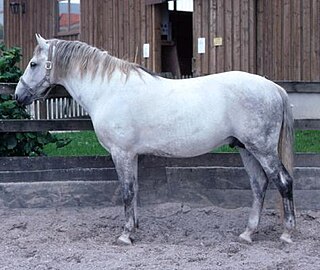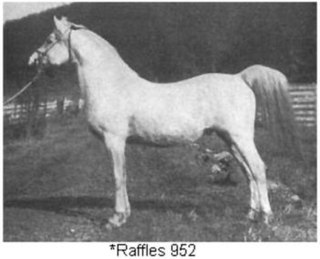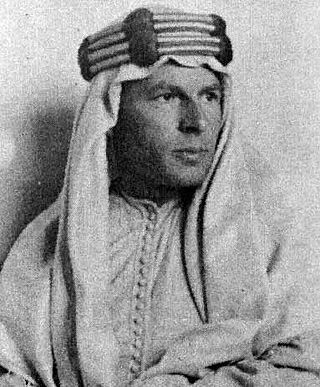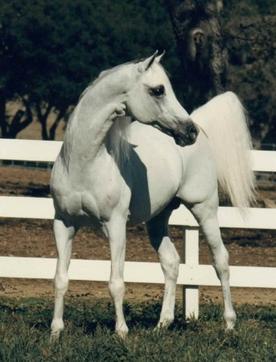
The Arabian or Arab horse is a breed of horse with historic roots on the Arabian Peninsula. With a distinctive head shape and high tail carriage, the Arabian is one of the most easily recognizable horse breeds in the world. It is also one of the oldest modern breeds. Although modern DNA cannot trace breed purity in the modern population beyond 200 years, there is archaeological evidence of horses in the Middle East with landrace characteristics that resemble modern Arabians dating back 3,500 years. Throughout history, Arabian horses have spread around the world by both war and trade, used to improve other breeds by adding speed, refinement, endurance, and strong bone. Today, Arabian bloodlines are found in almost every modern breed of riding horse.

The Lipizzan or Lipizzaner is a European breed of riding horse developed in the Habsburg Empire in the sixteenth century. It is of Baroque type, and is powerful, slow to mature and long-lived; the coat is usually gray.

Mesaoud, an Arabian stallion, foaled 1887, was one of the foundation sires of the Crabbet Arabian Stud in England. Bred in Egypt by Ali Pasha Sherif, he was imported to England by Wilfred and Lady Anne Blunt in 1891. He is recognized as an Al Khamsa Arabian, with verifiable lineage tracing to the Bedouin of the desert.

Raffles was an Arabian stallion foaled in 1926 and imported to the United States by Roger Selby in 1932. Raffles was bred by Lady Wentworth of the Crabbet Arabian Stud.

Khemosabi (1967–2001) was a bay Arabian stallion with four stockings and a blaze, who had significant accomplishments in the horse show ring, winning multiple National Championships in both halter and western pleasure performance competition. These wins earned him the highest level achievement award offered by the Arabian Horse Association: the Legion of Masters. In the course of his breeding career, he sired over 1200 foals. Of these, over 300 were show champions and 75 won national championships.

Indraff (1938–1963) was a gray Arabian stallion, foaled on May 9, 1938 and bred by Roger Selby of Ohio. His sire was Raffles and his dam was Indaia. Both his sire and dam were bred by the Crabbet Arabian Stud in England and imported to the United States by Selby.

Raseyn (1923–1959) was an Arabian stallion foaled in 1923 and bred by Lady Wentworth of the Crabbet Arabian Stud. After being imported into the United States by W.K. Kellogg in 1926. He was part of a large shipment of horses that Carl Schmidt, later Carl Raswan, purchased from Lady Wentworth for Kellogg's new ranch in Pomona, California.

Bask, bred at the Albigowa State Stud in Poland, was a bay Arabian stallion who was imported into the United States in 1963 by Dr. Eugene LaCroix of Lasma Arabians and became a major sire of significance in the Arabian breed.
An Austrian Warmblood is a warmblood type of horse registered with the Arbeitsgemeinschaft für Warmblutzucht in Österreich. Although the studbook is made up of jumping and dressage horses from many other countries, the mare base consists of native horses with a long history. The AWÖ keeps an open studbook, in which mares and stallions must pass rigorous inspections before becoming breeding stock.

The Marbach Stud, German: Haupt- und Landgestüt Marbach, is Germany's oldest state stud farm for horse breeding, has a history that dates back over 500 years. It is located in southwest Germany near Gomadingen in the Reutlingen district of Baden-Württemberg. The annual stallion parade is an internationally known attraction, and the stud hosts over 500,000 visitors per year. The stud also offers courses for those wishing to learn to ride or drive, as well as an instructor training program. Marbach is known for producing athletic horses with good temperaments, and has careful management practices, including that of allowing young, untrained horses the opportunity to grow in a natural setting conducive to their mental as well as their physical development.
The Tersk Stud is a horse stud farm, and it was used to restore the Russian horse population, which suffered heavy losses during the 1917-1923 Revolution. It was officially established on 11 February 1921, on the orders of Marshal Semyon Budyonny.

Carl Reinhard Raswan, born Carl Reinhard Schmidt, was one of the greatest connoisseurs and patrons of the asil Arabian horse. He authored numerous books on Arabian horses and the Bedouin people who raised them. A scholar of Arabian bloodlines, he also published the Raswan Index, an extensive compilation of Arabian horse pedigree and strain information. He advocated tolerance and understanding of Bedouin ways of life and culture in Arabia.

Sheila Varian was an American breeder of Arabian horses who lived and worked at the Varian Arabians Ranch near Arroyo Grande, California. She grew up with a strong interest in horses, and was mentored in horsemanship by Mary "Sid" Spencer, a local rancher and Morgan horse breeder who also introduced Varian to the vaquero or "Californio" tradition of western riding. She started her horse ranch, Varian Arabians, in 1954 with the assistance of her parents. Raising and training horses was her full-time occupation beginning in 1963. She used vaquero-influenced methods of training horses, although she adapted her technique over the years to fit the character of the Arabian horse, which she viewed as a horse breed requiring a smart yet gentle approach.

Naborr, originally named Nabor, was a gray Arabian stallion foaled in Russia at the Tersk Stud. He was sired by Negatiw, a Russian-bred stallion with Crabbet ancestry, out of the Polish-bred mare Lagodna. After establishing himself on the race track and show ring in the former USSR, Naborr was exported to Poland, where he lived for seven years, and from there was purchased for import to the United States by a wealthy Arabian horse breeder from Arizona, Anne McCormick. Upon her death, Naborr was sold in 1969 to Tom Chauncey and Wayne Newton for $150,000, which was at the time the highest price ever paid for an Arabian horse at auction. He went on to become a leading sire of champion Arabian horses in the United States and Canada.

Negatiw, sometimes anglicized Negativ, was a gray Russian-born Arabian stallion. He was sired by Naseem, a Skowronek son bred in England, out of the Polish-bred mare, Taraszcza. Negatiw was credited as the stallion that returned the Ibrahim sire line to Poland. He is also regarded as the most internationally influential grandson of Skowronek.

Bandos was a gray Arabian stallion with Crabbet ancestry. He was sired by Negatiw, a Tersk bred stud, out of Bandola, who was known by the title of "Queen of Poland". Bandos was a sire in Poland for 11 years, and in 1982, he was imported to the United States.

Bandola was a gray Arabian mare, known for her title, "The Queen of Poland." She was sired by Witraz, out of the Polish-bred mare, Balalajka.
Ronteza (1954–1982) was a bay Arabian mare who was the first of her breed to win the Grand Champion Reined Cow Horse class. She was sired by Witez II, out of Ronna.

Bay-Abi was a bay Arabian stallion who was a foundation sire of Varian Arabians, and national halter champion. He was sired by Errabi, out of Angyl.

The Janów Podlaski Stud Farm is the oldest state stud farm in Poland, established in 1817 in Wygoda. The stud farm specializes in breeding Arabian and Anglo-Arabian horses. It has been an important stud farm for the Arabian horse breed for the last 200 years despite being plundered in 1914 and 1939 by Russia. The annual horse auction at Janów Podlaski, called Pride of Poland, is considered one of the leading and most prestigious sales of Arabian purebred horses globally.

















